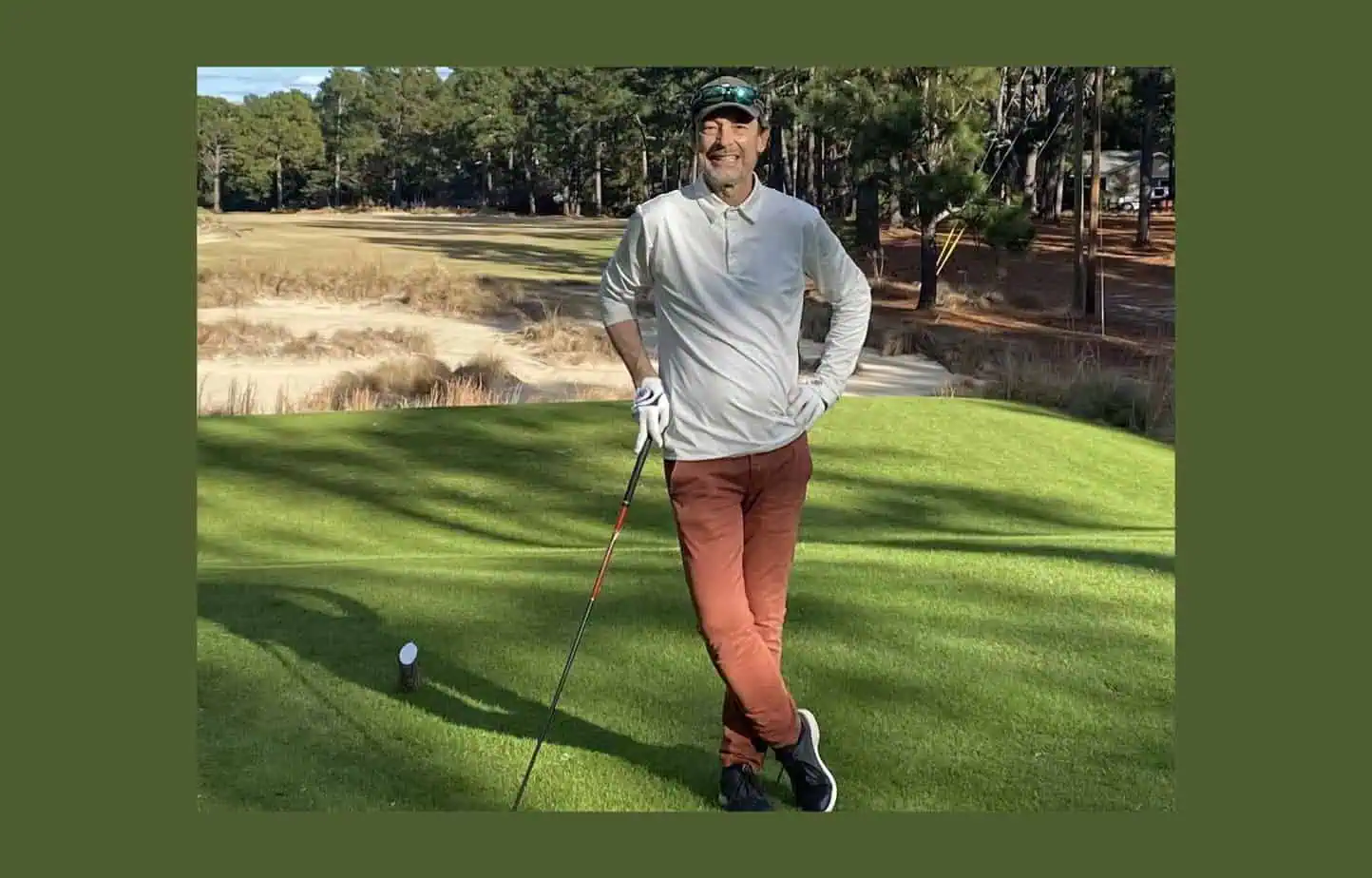Affordable golf courses are a key issue
How is the position of golf developing within society? We wanted to find out from Orin Starn, Professor of Anthropology and History at the renowned American Duke University. Starn, whose research often focuses on the relationship between different sports and society as a whole, is the author of several books. These include Tiger Woods: An Anthropologist Reports in Golf, Race and Celebrity Scandal. In the past, Starn’s articles have been published in newspapers and magazines such as The New Yorker and the Los Angeles Times.
Orin, please tell us how you got into golf?
Orin Starn: I started playing when I was 11 or 12. Neither of my parents played golf, but all of my grandparents played golf. So for me, golf was a gift because it was a way for me to connect with them. I grew up in Berkeley, California, and there’s a golf course called Tilden Park – a legendarily hilly municipal course – where I played. It was strange to play golf in Berkeley in the 1960s and 70s, because Berkeley was a left-wing campus town, the so-called People’s Republic of Berkeley, and there was the summer of love, and hippies, and protests. Golf and its more conservative vibe didn’t seem to go along with all of that very well. I kept playing into my early 20s, stopped for a decade or so, as my body stopped wanting to play soccer and other more demanding sports. I also moved then to North Carolina to become a professor at Duke University and we have such great courses in this area – Pinehurst, Pine Needles, Tobacco Road and so many more – that it seemed a shame not to play. I get out once a week or so now.
As an expert in anthropology, you also look at golf from a social and political perspective. How would you describe the current situation of American golf?
Orin Starn: There are two traditions of golf: One is the more country club tradition, which is more exclusive with an earlier history of discrimination. Women, Black Americans and sometimes Jews were not welcome for many decades. It remains expensive. But there was also always the tradition of municipal golf, a more democratic golf tradition of public courses. Any city in America or even town of any size has a public municipal course where it’s usually not too expensive to play. Although golf is still viewed in America as a sport for wealthy people, really it’s a pretty wide demographic that plays golf here in the U.S. It’s still a bit haunted by its country club past, but in other ways it has just become another sport in the U.S.
Let’s talk about the future of golf. How important is social acceptance for the future when we talk about discussions such as land use?
Orin Starn: We definitely had a progress in the greening of golf courses and greater awareness of sustainability issues in the U.S. The place where you hear the most complaints in the United States about golf is probably in the Southwest and in areas like Phoenix and Tucson, which are in the desert and where water scarcity is on people’s minds. In terms of access for people of all backgrounds, programs like First Tee or Girls Golf are important, because golf has to be inclusive. Golf has made some progress in terms of attracting a more diverse group of players in the normal clubs, where, for example, the number of Black golfers has grown considerably. But that is not reflected on the PGA Tour, where we had Tiger and then since barely any Black pros at all. The PGA Tour has certainly become more diverse with more Asian players, but regarding black players it seems if anything, we’ve gone backwards in the numbers.
How can this be changed?
Orin Starn: The one thing that I feel like we need is for affordable golf to be expanded. We see the building of many very expensive boutique new courses, with green fees of a couple of hundred dollars or more. And you don’t see a lot of new public courses getting built. Here in North Carolina public courses tend to be very packed. Less affluent golfers are finding themselves choosing between six hour rounds at municipal courses that are overcrowded or not playing golf at all. So expanded access to reasonably priced courses seems to me a key issue as far as it comes to golf and politics.
In terms of climate change, we see famous athletes advocating for behaviour change in certain sports. There is no famous golfer who does that. Is golf apolitical?
Orin Starn: Orin Starn: In other sports we have LeBron James or a number of famous athletes like Megan Rapinoe, the soccer player, who are not shy speaking about racism or LGBTQ rights or other social issues. By contrast, I can’t think of a professional golfer taking a strong political stance about anything. There have been surveys of the political leanings of U.S. professional players. And, you know, most of them are Republicans and Trump voters. Jack Nicklaus endorsed Trump. So I think many of these golfers either don’t have political views or if they do, they’re pretty conservative ones. And they’re not likely to join protests for climate or racial justice or other causes that might rock the boat.
Professional golf seems to be at a turning point in terms of the future of tours and sponsorship. Will this lead to a greater divide between amateur and professional golf in the future?
Orin Starn: It’s an interesting moment because TV ratings are down for golf in the U.S. Because of corporate sponsorships and because there’s a lot of money to be made in streaming golf tournaments, there’s still a lot of money in professional golf. But, personally, I can’t remember a time in the last 10 or 15 years when I was less interested in professional golf. Partly because Tiger’s not playing, who with his charisma and golf genius was always a must-watch. But I don’t think it’s a moment where there’s a lot of gripping, interesting personalities in professional golf. And yet, conversely, the United States is a time where everyday recreational golf and the numbers of golfers is really flourishing and growing, with the pandemic part of the explanation as people looked for outdoor activities.
Do you believe that golf in the USA will be able to adapt to the challenges of climate change in the future?
Orin Starn: In North Carolina for example, almost all courses have changed from bentgrass to bermuda, because summers have gotten progressively hotter. You see less watering, too, more waste areas. For the moment, golf has been able to adapt. But how long will that be possible as the consequences and effects of climate change become more inescapable?
The adaptation of golf will cost money. The golfer will have to pay. How difficult is it to get the average golfer excited about change?
Orin Stark: When I play golf and talk to other golfers, I don’t find a lot of people who are thinking about much else than having a good time, relaxing, and getting a beer in the clubhouse. I don’t think there’s a very strong level of self-awareness among golfers about the political, social, environmental context of golf. And, as mentioned, the professional golf tour is very depoliticized. It’s a shame because there are so many interesting issues and challenges around sustainability in golf. But I don’t think that we will be seeing that reflected in big protests, like in England at Manchester United, when regular fans were no longer able to go to a match in the stadium. Those kinds of protests are unimaginable in golf, with its more establishment feel. Maybe it’s because it has always been a more expensive sport or because people have more education.
Why is it so difficult to get golfers interested in sustainability?
Orin Stark: Many clubs have this rhetoric of sustainability. We read this: “We’re protecting the land, we’re not using a lot of water, we’re using non-invasive plants, we’re using sand from local quarries”. It all sounds good, although I’m not sure how much of it is more cosmetic “greenwashing” or amounts to real change. For example, I played at Bandon Dunes in Oregon, which embraces sustainability. But everyone is flying in to play from thousands of miles away. Probably, the net carbon emissions balance of the courses there is really lousy for that reason, but we tend not to think about that part of it.
Orin, if you were president of the USGA for a week and had to make golf in the USA fit for the year 2050, what would you do?
Orin Stark: Wow, that’s a great question. I would build more affordable public golf courses, finding money for that. Number two, I would do everything possible to promote golf courses that are genuinely environmentally sustainable. And third, promote golf as a sport for everybody. When we look at the leadership in golf it’s still mostly white guys, with a business blazer country club feel. I think we have come a long way towards that, but there’s a lot more to be done.








 Image: Petra Himmel
Image: Petra Himmel